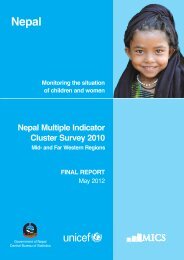Chapter 15 Internal Migration in Nepal - Central Bureau of Statistics
Chapter 15 Internal Migration in Nepal - Central Bureau of Statistics
Chapter 15 Internal Migration in Nepal - Central Bureau of Statistics
You also want an ePaper? Increase the reach of your titles
YUMPU automatically turns print PDFs into web optimized ePapers that Google loves.
The hill ranges <strong>in</strong> altitude from 610 meters to 4,877 meters with moist sub-tropical climate. It is<br />
the meet<strong>in</strong>g place <strong>of</strong> people com<strong>in</strong>g from the north and the south <strong>of</strong> the country. It occupies 41.7<br />
per cent <strong>of</strong> the total area with a population density <strong>of</strong> 167.1 persons per square kilometer and has<br />
44.3 per cent <strong>of</strong> the total population. This zone has 39 districts with many <strong>of</strong> the large urban<br />
centres <strong>in</strong> the country.<br />
The Tarai zone ranges <strong>in</strong> altitude <strong>of</strong> less than 610 meters with humid tropical and sub-tropical<br />
climate. It has 20 districts with only 23.1 per cent <strong>of</strong> the total area <strong>of</strong> the country but has a density<br />
<strong>of</strong> population almost twice greater (329.6 persons per square kilometer) than <strong>in</strong> the hills. In 2001,<br />
this zone had accommodated 48.4 per cent <strong>of</strong> the total population <strong>of</strong> <strong>Nepal</strong>.<br />
These ecological zones are important <strong>in</strong> the discussion <strong>of</strong> the patterns and trends <strong>of</strong> <strong>in</strong>ternal<br />
migration <strong>in</strong> the country. This is <strong>in</strong> the sense that there is a mounta<strong>in</strong> zone with sufficient land<br />
space and sparse population due to rugged topography, sloppy terra<strong>in</strong> and <strong>in</strong>hospitable<br />
environment and there is the hill zone <strong>in</strong> between the mounta<strong>in</strong> and Tarai with low agricultural<br />
productivity but is strategically located <strong>in</strong> terms <strong>of</strong> defense and development <strong>in</strong>itiatives. The<br />
proportion <strong>of</strong> area and population <strong>in</strong> this hill zone almost match but high environmental<br />
degradation, landslides, deforestation, haphazard development <strong>of</strong> both rural and urban settlement<br />
have made it difficult to develop. But people <strong>of</strong> all k<strong>in</strong>ds and creed jo<strong>in</strong> and run the ma<strong>in</strong>stream <strong>of</strong><br />
national life <strong>in</strong> this zone. The Tarai has a relatively hot climate with adequate ra<strong>in</strong>fall dur<strong>in</strong>g the<br />
monsoon season. It has rich and fertile agricultural land and has become the prime dest<strong>in</strong>ation <strong>of</strong><br />
the mounta<strong>in</strong> and the hill people <strong>of</strong> <strong>Nepal</strong> s<strong>in</strong>ce the very campaign <strong>of</strong> malaria eradication dur<strong>in</strong>g<br />
the late fifties.<br />
These three zones have been sub-divided <strong>in</strong>to <strong>15</strong> regions on the basis <strong>of</strong> five development regions<br />
and three ecological zones. Then there are 75 adm<strong>in</strong>istrative districts belong<strong>in</strong>g to three zones and<br />
five development regions. In 2001 census, data on <strong>in</strong>ternal migration were provided at the district<br />
level as well as by <strong>in</strong>dividual towns. <strong>Nepal</strong> has now 58 urban centres located <strong>in</strong> various districts<br />
<strong>of</strong> <strong>Nepal</strong> with a total urban population 14 per cent <strong>in</strong> 2001. Rural to rural migration stream gett<strong>in</strong>g<br />
gradually shifted towards rural to urban followed by urban to urban and urban to rural represents<br />
different stages <strong>of</strong> development <strong>of</strong> the <strong>Nepal</strong>ese population.<br />
<strong>15</strong>.1.2 Demographic Background<br />
In 2003, <strong>Nepal</strong>'s population is estimated to have reached 25.1 million with a density <strong>of</strong> 179<br />
persons per square kilometer [United Nations, 2003]. <strong>Nepal</strong> ranked 143rd <strong>in</strong> human development<br />
<strong>in</strong>dex <strong>of</strong> 2003 [UNDP, 2003]. Every two <strong>in</strong> five persons <strong>in</strong> <strong>Nepal</strong> lives below absolute poverty<br />
123
















